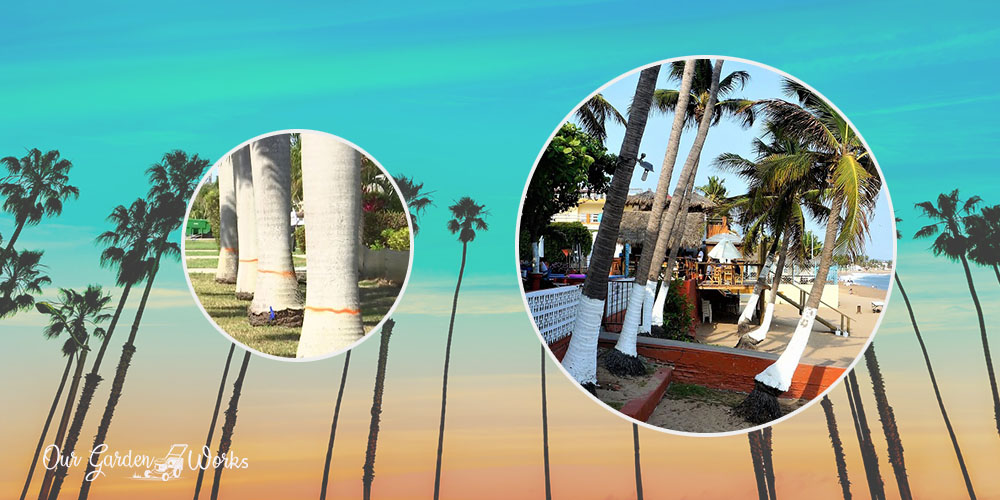Palm trees are one of the hallmarks of the tropics. You will mostly find them on coastlines swaying along the sea breeze. However, why are palm trees painted white? The obvious answer is aesthetics, but there are reasons and history behind this practice.
In this post, learn about the different meanings of paint colors in palm trees and how you may use them in your yard too.
Q: Why are palm trees painted white?
Palm trees that are painted white have a cultural, horticultural, and functional essence to a specific region or country.
The painting process of the trunks is called whitewashing in tropical and subtropical parts of the US. Discover the five possible reasons why communities paint their palm tree trunks white.
#1 Improve visibility on critters
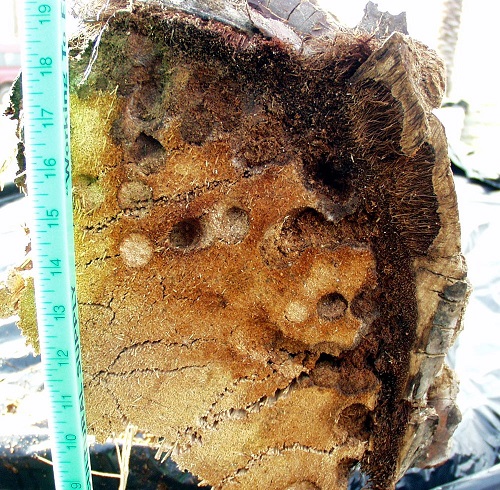
Palm trees are painted white so that farmers and palm tree growers can easily see critters creeping from the ground up to the trunk.
The paint also serves as a coat or barrier that protects the bark from the bites and tunnels caused by the pests.
Palm trees have long trunks, making them an easy target for boring insects. Once the tree trunk is wounded, the tree becomes more susceptible to diseases that increase its risk of premature death. The holes tend to ooze with a gel which indicates fungal infection.
The pest damage on palm trees can be destructive, leading to a significant loss to palm tree growers and wreak havoc on the biodiversity of plant species in a country or region. Once a palm tree dies, it will take around 2 to 5 years to become productive.
The common pests that attack palm trees include:
(1) Red palm weevil (RPW): RPW is considered the most damaging palm pest in the world. They are beetle-like pests that can topple down a tall mature palm tree.
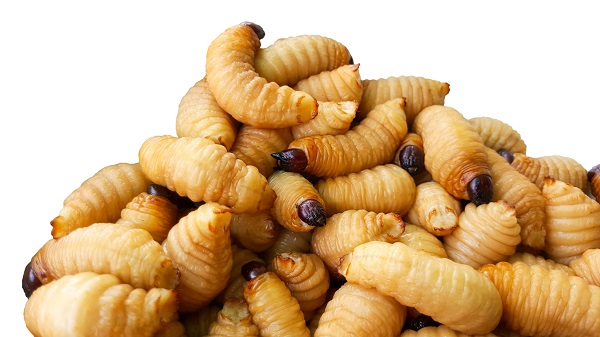
Their larvae create tunnels in the trunk and at the base of the fronds and feast on their plant tissues. The damage will start from inside to outside until the palm tree trunk can no longer support its crown.
Since adult RPW can fly up to 900m, they can travel from the ground to the bottom part of the trunk in a split second.
RPW infestations in several countries are taken seriously by authorities as they can immensely affect the biodiversity and survival of palm trees in the region.
The telltale signs of RPW infestation are as follows:
- Visible tunnels on the trunk or fronds.
- Chewing or grinding sounds in the tree trunk due to feeding RPW larvae.
- Gel oozed from the entrance of the tunnels.
- Ground palm tree fibers or frass on the holes in the tree trunk.
- The unusual smell from the tunnels or gel.
- Dead RPW around the infected tree.
- Mysterious breakage of the palm tree.
(2) Giant palm borer: Giant palm borer is a larva of giant beetles which causes secondary plant stress on palm trees. They only attack dead and stressed palm trees affected by excessive pruning or transplant shock.
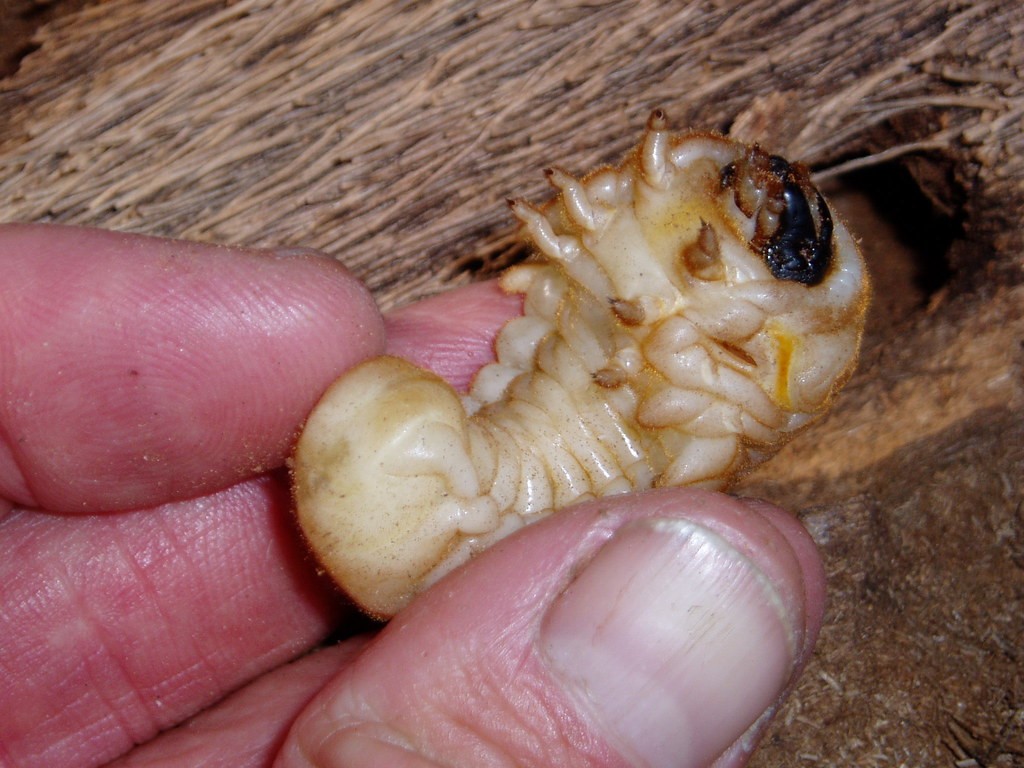
A borer-infected palm tree may not show any signs during the first few days until its fronds start to fall and the crown suddenly dies.
Like RPWs, they also create tunnels on the trunk and cause irreparable damage to the palm tree.
Unfortunately, once a palm tree is infested with palm tree borers, it is a point of no return. Cutting the tree is the only way to prevent adult beetles from laying eggs and larvae on neighboring palm trees.
#2 Mark territory or make the tree more visible to vehicles
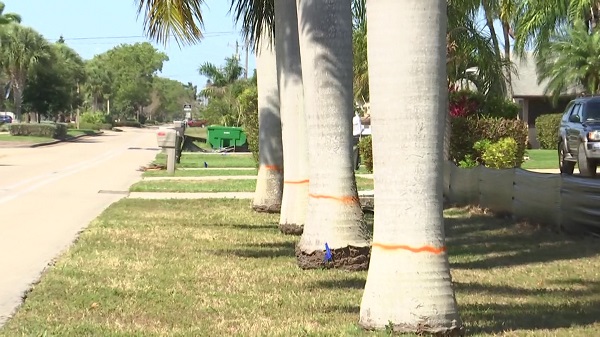
Palm trees lined up along coastal highways are sometimes painted white as a guide to vehicles at night.
Sometimes they use it as a mark of territory to remind motorists that they have entered a specific city or landmark.
Arborists in some regions paint palm trees white to warn drivers of an upcoming curve or intersection. They add red lines on top of the white paint to improve the visibility of what’s on the road ahead.
#3 Protect the trunk from sunscald
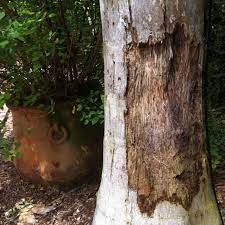
Popularly known as southwest winter injury, sunscald affects not only palms but almost all types of trees during winter.
It happens when the bark cracks and splits due to temperature fluctuations between cold nights and direct sunlight during the day.
Once the bark splits or cracks, the damage will look like elongated black marks. The damage to the bark happens when the sun hits and warms up the southwest part of the trunk during winter.
As the sun goes down, the warmed area will have no time to be hardy enough to endure the freezing night temperatures.
Gardeners and arborists paint palms and other thin-barked trees with white paint to prevent the bark from warming up too much and be hardy enough to protect itself at night.
#4 Uphold the cultural practices of the region or country
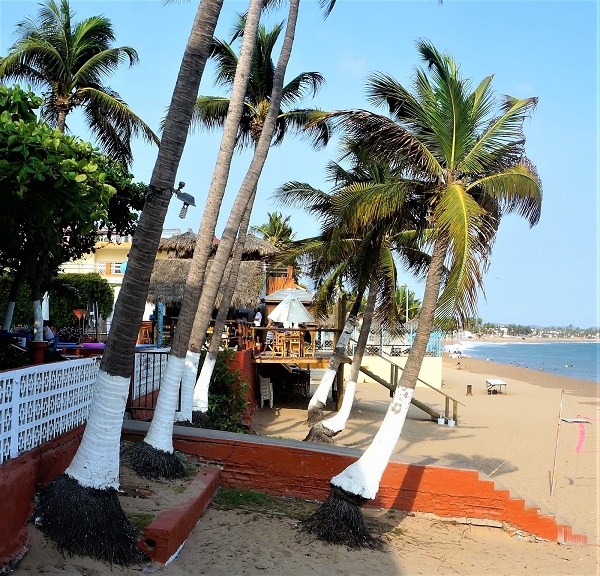
Who would have thought that a simple painting or whitewashing on the palm tree trunk holds so much meaning, ranging from military strategies to spiritual significance?
One of the most peculiar histories about whitewashing palms is its essential role during World War II.
Without technology during WWII, the military painted trees white with other markings, surrounding their enemies without causing alarm.
To be invisible to the aerial jets, American soldiers paint the trees along the convoy of their vehicles so they can move without light.
The practice of painting trees became a part of the culture and has lived on in some states. The boomer generation would often recall their childhood seeing plenty of whitewashed trees.
However, the practice has slowly declined throughout the years. In the spiritual world, painting palms and other trees with white paint signifies good energy from the spirit world.
An excerpt from Big Book of Soul: The Ultimate Guide to the African American Spirit also discussed the spiritual significance of whitewashing trees and how it affects a specific location.
#5 Improve aesthetics of the location and prevent vandalism
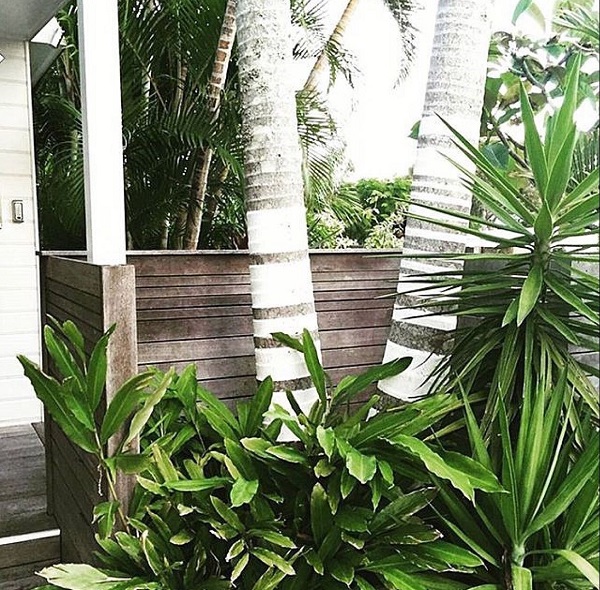
Resorts and beach houses designed with themes of blue and white or Balinese styles often match the aesthetics of their landscape by painting trunks with white paint. Sometimes, they also paint the pots white to match the elements in the garden.
In public areas, people tend to mark the trunks of palm trees with their names or vandalize them with spray paint.
Authorities uniformly paint the palm trees white to rehabilitate the area and discourage the public from writing or wounding them.
You might like: Quick & Easy Palm Talks: Do All Palm Trees Produce Coconuts?
What different tree paint colors and markings mean
If you have a keen eye, you will notice that some trees have different colors and markings other than white. While most colors are just for aesthetics, some hold a specific meaning.
Knowing the meaning behind tree colors and markings can help save you in times of danger or keep you from trespassing on private property.
Check some of the usual tree marks below:
- X mark: Hazard tree or a tree for removal. Sometimes people use it to leave and skip a tree for cutting.
- Numbers: They represent the tree count used for harvesting trees.
- Purple: Universal sign about no trespassing or indicating a property boundary.
- Red: US Forest Service land boundary.
- Orange or yellow: Sign of harvest boundaries wherein the trees that they surround are for harvest.
- Black: Correction of a mark or color used on a tree.
- Green: Trees to leave.
Though the meaning of the markings and colors above are known to many, tree experts and arborists warn everyone that sometimes the symbol or meaning of these markings or colors vary depending on the landowner.
Some local governments may also alter the representation of the tree colors based on their preferences. Therefore, better to ask local authorities or residents before touching trees in a specific area.
Type of paint ideal for palm trees
Water-based latex paint is the best type of paint to use on marking trees. It allows the bark to breathe while protecting it from pests and the elements. Latex paints these days are now available in aerosol sprays and pints.
If you’ve been looking for ideal brands to use, here are some options that you can choose from:
- White: Krylon APWA Brilliant White Water-Based Marking Paint
- Orange: Tree Marking Paint, One gal, Orange, Water -Based
- Red: Aervoe Tree Marking Paint, Red, 16 oz.
- All colors: Rust-o-Luem Tree Marking Paint
You might like: Growing Tropical Trees: Do Palm Trees Have Roots?
How to paint palm trees
Painting a palm tree may look so straightforward. However, painting one the wrong way can do more harm than good. Sometimes, you may mix some chemicals into the paint to improve your chances of getting rid of pests.
Here are some tips for painting your palm trees:
- Mix insect repellents or lime with white latex paint to help trap insects. However, beware of using oil-based repellents as they may cause more harm to the tree than to pests.
- Spring and autumn is the best time to paint trees. For maintenance, it’s best to paint the trees twice a year.
- The best time to paint the trees is as the snow melts in the ground. The cold is necessary to prevent the pests from crawling on the tree as the weather starts to warm up in spring. This timing is crucial because some spiders tend to hibernate in the bark.
- The ideal height in painting the trunk is 4.5 feet or breast height for full coverage.
- Painting palm and fruit trees in the fall will help protect the bark from glaciation and sunscald during winter.
Final Thoughts
We hope this post helped you discover the hidden meanings behind the paint color on palm trees. So, whenever someone asks you: why are palm trees painted white? You can share the different meanings behind whitewashing.
Aside from having the right goal, whitewashing should be done at the right time. Otherwise, you’ll beat the reason why you’re painting the palm trees anyways. It is especially true if the bugs find their way into the trunk before you even paint the surface.
Do you know other interesting facts about why people paint their palm trees white? Share your story in the comments below, and let the practice continue to the next generation.
Also, please share this post with your friends who grow palm trees in their yards to help them protect their trees from damaging pests and extreme weather conditions. Happy gardening!
